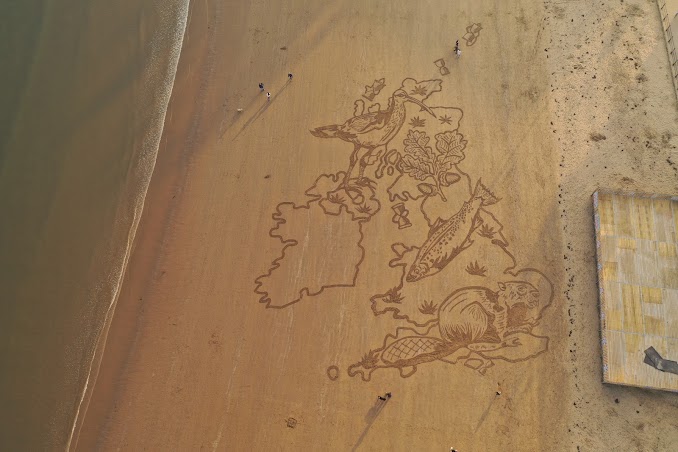“To restore stability to our planet, we must restore its biodiversity, the very thing we have removed. It is the only way out of this crisis that we ourselves have created.” – David Attenborough
Sustainable Development Goal of the month for April is Life on Land; life that we as a species are increasingly putting in jeopardy.
Humans live alongside millions of other species; but when it comes to sharing the planet, we are by far the most selfish, and the most destructive. According to UNEP, human activity has altered almost 75% of the earth’s surface, with dangerous knock-on effects. IPBES estimates that around one million animal and plant species are threatened with extinction globally, with the clock counting down not in centuries, but in decades. The figures speak for themselves: time is running out to prevent what could become irreversible changes.
And it does not stop there; the true danger is what lies around the corner. Several years into a pandemic, we already have some idea of the global devastation caused by the zoonotic diseases that emerge from damaged ecosystems. What happens when we have destroyed the forests which are home to 80% of all terrestrial species of animals, plants and insects; which help support 1.6 billion people; and which play a vital role in the fight against climate change? From the global economy, to the global health system, to the climate itself: biodiversity is not only our greatest asset, but risks becoming our greatest failure.
“We need to protect nature, restore ecosystems and establish a balance in our relationship with the planet. The rewards will be tremendous.” – UN Secretary-General Antonio Guterres
UK Youth for Nature: hope for the future
But there is reason to hope. Community conservation initiatives to protect local species are of crucial importance in the wider fight against nature loss. UNRIC spoke to Talia Goldman, Co-Director of UK Youth for Nature, an organisation leading the way on mobilising young people in the fight to prevent nature loss and protect biodiversity across the UK.
Tell us a bit about your organisation.

UK Youth for Nature is the UK’s leading youth movement calling for urgent political action to address the nature crisis. We’re an incredibly ambitious, focused, passionate, nature-loving group of 16-35 year olds from a broad range of backgrounds. We’ve been on a mission since 2019 to mobilise and empower young people to directly engage in and campaign for political change on nature and wildlife across all four nations of the UK.
What methods do you use to get your message out?
We fundamentally believe in the power of art and visual media to engage people in our campaigns and to communicate our demands and asks in a way that leaves a lasting impression. When we campaign, we want to bring the credibility of our aims and the importance of the UK’s wildlife and nature right to the heart of politicians and political representatives. We also take to social media, write letters, meet with politicians, work with organisations around the UK, and a whole lot more.
Why is biodiversity so important in the UK?

And yet the UK is home to an incredible number of unique landscapes, habitats and species – ones that can provide us with vital ecosystem services for our health and for mitigating climate change, and the cultural benefits of fantastic natural beauty. From the Sefton coast sand dunes and endangered Essex oyster beds to the majority of the world’s chalk streams found in Southern England, the fragments of the Atlantic coastline’s temperate rainforest, and our vast mudflats vital for overwintering migratory birds, we live in nations full of variety but in dire need of greater protections, investment in restoration, and impactful policymaking.
You recently pulled off a 50m sand drawing on Scarborough beach to highlight the loss of species all around the UK. What was the aim behind this “nature stunt”?
With the help of sand artists Sand In Your Eye and the support of numerous UK conservation organisations including the RSPB, Curlew Action, WWF, the Bat Conservation Trust, Froglife, and more, we drew a 50m long sand drawing of the UK enveloping four biologically significant British species: Eurasian curlew, Atlantic salmon, Eurasian beaver and Oak.
Drawn together, these species add up to more than the sum of their parts. We wanted to physically draw a line in the sand on no more nature loss. And as the drawing was washed away by the incoming tide, and we watched our islands, coastline, land mass, and critical species disappear, we raised the alarm about the future of our natural world.
What have you got planned for the future, and how can readers get involved?
We have a huge amount planned this year, campaigning at a national, regional and local level across the UK. Not only will we continue to shout loud and clear that Nature Cannot Wait, but we’ll be seeking specific change on issues such as freshwater pollution, access to nature, biomass and burning, restoration and a lot more to come.
We’re always looking for new members and supporters to join our network and our Organising Team! Get in touch on our Instagram or Twitter (@ukyouth4nature) or email us at [email protected].

